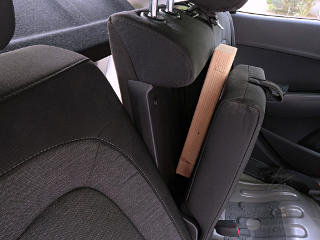
|
It is often useful to have a way to comfortably sleep in a vehicle,
which can save time and costs on a roadtrip.
Truckers do it all the time and sleeper-cabs are built for the purpose,
so drivers don't need to engage the lodging industry for most of their
overnights.
Quite a while ago I had set up
the equivalent
for the Prius, which involved a bit of technical hackery but served the
purpose extremely well over quite a few long journeys.
It's relatively easy because the Prius is surprisingly long and spacious
inside, allowing the whole right-hand side of the car to serve as
the "Prius motel" in rest-stops, campgrounds, and big-box parking lots.
The Kona, however, is so much shorter that the whole idea almost seems infeasible at first glance for anyone but midgets. The interior parts also seem antithetical to the effort: the front passenger seatback cannot be moved over nearly the same range to get it out of the way or make it part of the open flat space. Trying to drop it all the way back comes up against a hard stop in a totally inconvenient halfway-down position, and even that angle wouldn't be comfortable for a quick snooze in the front seat itself. On a brief evaluation of the seatback mechanics I decided that trying to modify the pivot and allow more range would probably be unduly involved, so I took the approach of filling in more flat area a different way. Simply dropping the rear split seatbacks normally opens up more of the "boot" area but the surface is definitely not flat, it tilts up quite a bit at the pivot point. The rear seat-cushion is too thick underneath, so the answer is to remove it as it's not really needed for a travel/camping scenario anyway. [It is held in with two bolted tabs at the back and a couple of pop-out plastic clips at the front edge.] But then the seatbacks flop down too far, angling the other way. What it needs is just the right amount of support underneath to bring the seatbacks flat with the line of the rear floorboard. |
| Nice start, but now the problem is to extend the plane and bridge the yawning gulf across the rear footwell up the shotgun seat. The front seat slides forward reasonably far, but annoyingly doesn't lean forward too much before hitting another hard stop, but that might just be enough room anyway. |
|
My usual sun-shade and privacy curtains took all of twenty minutes to adapt
to the Kona interior, and matter a little less around the rear half of the
car due to the tinted windows.
The window bug-screening hack works the same way, slotting open two
diagonal windows for passive ventilation in suitable weather.
What's very convenient is that there's no need for deep hackery to bring air through the car when it's closed up, because the Kona EV has a feature called "utility mode" which keeps the 12V system alive from the main battery in a fairly frugal way. With the car in that mode only running a low fan from the normal controls, total system draw is less than 200 watts on average -- maybe 6 or 7 miles worth of range for a typical overnight stop. I described some of this in a related forum thread, noting that all of the heating/cooling climate controls also function in that mode for handling more extreme temperatures, at the minor expense of more range lost. If anything that aspect is better than in the Prius, because we don't get the periodic jolts of an engine starting and stopping. As I noted in the post, if my bivouac is in, say, the parking lot of a big-box where public chargers tend to get located anyway, it's not a worry. And now I've got a place to catch a snooze while charging instead of sitting around being bored. With travel severely curtailed by the pandemic at the time of constructing this I don't expect to be using it a lot for a while, but it's nice to have something workable ready to go. Being able to remain as independent as possible helps to stay safer on the road, as Shelby describes here. Charging stations are completely outdoors, food supply can be brought along, and certain external needs [e.g. "coffee rental"] can be handled discreetly through my special water bottle labeled "NOT for consumption". My COVID kit would certainly come along too. With a little planning, an all-electric trip could be safer by comparison, by mitigating much of the need to be inside travel-plaza stores and staying aware of exposure risks when needed. |
_H* 200610